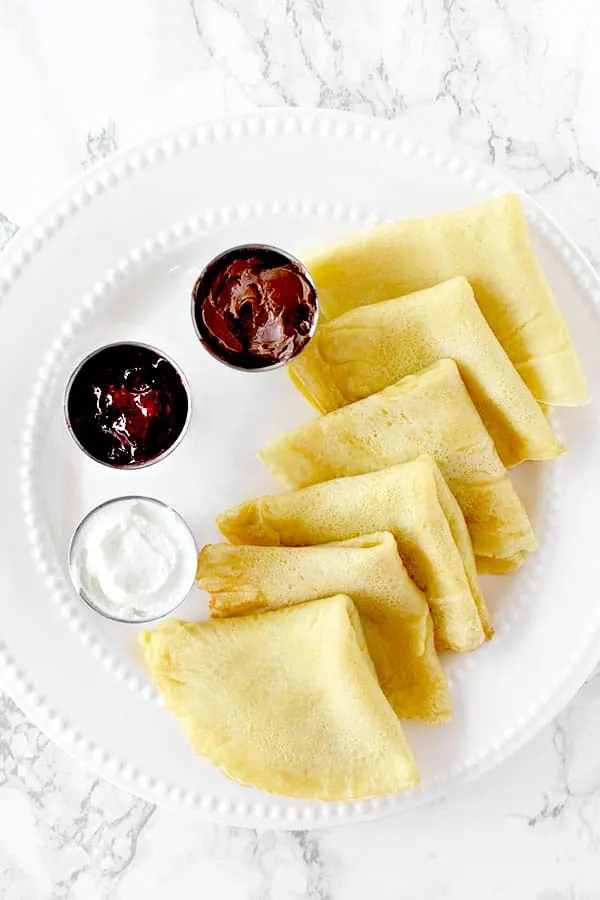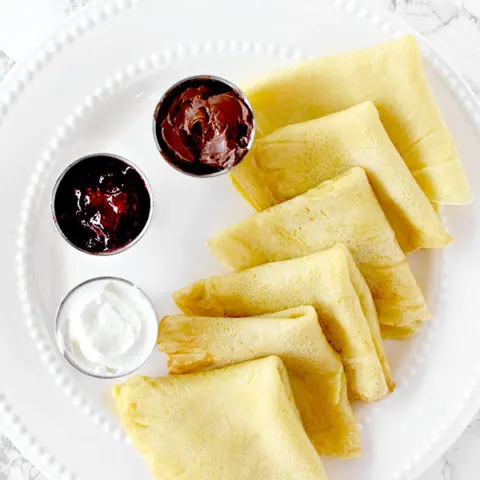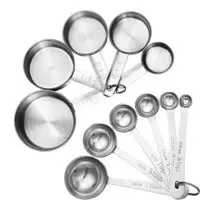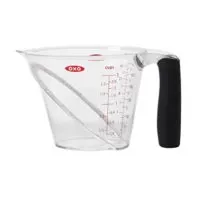These dairy free crepes made without butter or milk, but are so good you won’t even notice. Serve as a dessert with jam or dairy free cream.

While crepes are French, they are beloved internationally. Crepes translates to pancakes in English, but if you’ve ever had an American pancake, you know they are not the same thing.
Crepes are very thin and can be made either sweet or savory.
This recipe is for classic sweet crepes - made dairy free - which is usually eaten for dessert.
The first time I ever had a crepe was shortly after I moved to Israel. I was living in an absorption center with people from 34 other countries.
I’ve always been very interested in other cultures, so for me this was incredible.
One of my favorite groups to spend time with were the French, and one night I was invited to join a crepe party in one of the rooms.
I wasn’t surprised to see that I was the only non-French person there.
We ate crepes with jam and Nutella, listened to French music, and later the three of us watched a French film.
I felt like I was in Paris in one of my friends' apartments and to this day, that night is one of my favorite memories.
Since then, I've loved crepes and make these dairy free crepes often.
This recipe is easy to make and completely authentic, except that I made it dairy free. Though, honestly, I don’t miss the milk at all.
HOW TO MEASURE FLOUR AND OTHER DRY INGREDIENTS
The best way to measure dry ingredients is with a scale. However, this is not commonly done in the United States, where dry measuring cups are used instead.
To measure most dry ingredients, first spoon them into a dry measuring cup and then level off the measuring cup with an upside-down butter knife.
Make sure not to pack it down because it can lead to using more of the ingredient than called for.
The exception is brown sugar. To measure brown sugar, pack it into the measuring cup and then level off any excess.
To measure chocolate chips, nuts, or dried fruit, just pour them in and then level them off.
DRY VS LIQUID MEASURING CUP
Dry measuring cups are a set of cups that often come with measuring spoons. Each cup is a different measurement just like each spoon is a different measurement.
Liquid measuring cups, on the other hand, are cups that have measuring lines on the side to mark the measurements.
The problem with using liquid measuring cups to measure dry ingredients (like flour and cocoa) is that they are powders. So, as you shake the cup to level them off, the powders settle and you end up with more than you need.
I tested this with a friend who didn't believe me and we ended up with a number of tablespoons more than the recipe called for.
WHY sift Powdery Ingredients
There are a number of benefits to sifting powdery ingredients like flour and cocoa.
First of all, flour is often sifted before use to aerate it and remove any lumps. This helps in achieving a lighter texture in baked goods.
Secondly, if you measure flour that's just been sifted, you can get a more accurate measurement than from flour that's been packed tightly in a bag.
In addition, sifting dry ingredients together, such as flour, cocoa, and baking powder, helps make sure they're evenly dispersed.
WHICH TYPE OF OIL TO USE
I use neutral oils like canola oil, safflower oil, and vegetable oil. However, if preferred, oils with stronger flavors like coconut oil or olive oil can be used.
If using olive oil, I recommend using pure olive oil for its more mild flavor and higher smoke point.
Sugar
The primary role of sugar is to be a sweetener. However, sugar also contributes to the tenderness and moistness of the baked good by absorbing and retaining moisture and helps create the golden brown color when baking as it caramelizes.
Recipes with more sugar often result in softer, moister textures. However, I learned the hard way that too much sugar leads to a sticky mess.
When it's heated, sugar caramelizes, resulting in a rich, complex flavor and a brown color. This adds both flavor and color to baked goods and is also the process in which caramel sauce, dulce de leche, caramel candies, and regular candies are made.
When used in recipes containing yeast, the sugar is eaten by the yeast, producing carbon dioxide and causing the dough to rise.
Sugar also acts as a preservative in jams, jellies, and fruit preserves by reducing water activity and preventing microbial growth.
There are many different types of sugar, including white sugar, brown sugar, vanilla sugar, powdered sugar, turbinado sugar, and demerara sugar.
When a recipe calls for “sugar” without specifying anything else, it's referring to regular white sugar.
White Sugar
White sugar (sometimes called granulated sugar, table sugar, or white granulated sugar) is made of either beet sugar or cane sugar, which has undergone a refining process.
It is the easiest to find and most commonly used.
Brown Sugar
Brown sugar is white sugar with molasses added to it.
It is commonly used in chocolate chip cookie recipes, and it’s rare for a recipe that calls for brown sugar not to also call for white sugar as well.
When a recipe calls for “brown sugar” but doesn’t specify what type (light or dark), it is referring to light brown sugar.
In my recipes, you can use whatever type of brown sugar you have on hand, whether it is dark brown sugar, light brown sugar, or demerara sugar - which is very common in Israel.
Just keep in mind that the flavor and color will be slightly different, depending on what you choose to use.
Turbinado Sugar
Turbinado sugar is better known as "raw sugar." But, despite this name, the sugar is not really “raw.”
Instead, it's partially refined sugar that retains some of the original molasses.
The term "raw sugar" may also give off the impression that it is somehow healthier.
In reality, turbinado sugar is nutritionally similar to white sugar.
Demerara Sugar
Demerara sugar is very popular in Israel and is especially delicious in tea, but is also used for baking.
Unlike white sugar, demerara sugar undergoes minimal processing and retains some vitamins and minerals.
However, it is still not much healthier than white sugar.
Vanilla Sugar
Vanilla sugar is not very common in the States. However, it is common in Israel and parts of Europe.
This is sugar that sat for an extended period of time with vanilla beans, giving it a vanilla flavor.
Caster Sugar
This type of sugar is common in the United Kingdom.
It has a grain finer than white (granulated) sugar and larger than powdered sugar.
Caster sugar is often called for in recipes for delicate baked goods like meringues, souffles, and sponge cakes.
You can use a 1:1 conversion rate between caster sugar and white (granulated) sugar.
Powdered sugar
Powdered sugar, sometimes known as confectioners’ sugar, is a sugar with a powdered texture.
This sugar is rarely used for baking. Instead, it is used for dusting desserts and making frosting, icing, and glazes.
In some countries, you can also find powdered vanilla sugar.
It is made the exact same way regular vanilla sugar is made. However, the sugar used is powdered instead of granulated.
Vanilla Extract vs Vanilla sugar
In my recipes, I don’t specify what kind of vanilla to use.
The reason for this is that in the States, vanilla extract is exclusively used.
Meanwhile in Israel, along with many European countries, vanilla sugar is common.
In most, if not all recipes, both vanilla extract and vanilla sugar can be used.
In recipes where vanilla sugar can be used instead of extract, you can replace them 1:1.
Replacing Sugar with Honey
If you’d prefer to use honey instead of sugar, you can do so with pretty good results.
Honey can be two or even three times as sweet depending on the honey, so for every 1 cup of sugar, you can use ½ to ⅔ cup honey.
Since honey adds liquid, you need to remove some to balance it out. For every cup of honey, remove a ¼ cup of liquid.
Also, it burns faster than granulated sugar, so you want to lower the baking temperature by 25 F. In addition, check it early and often to avoid burning or overbaking.
How to Store Sugar
Sugar should be stored in an airtight container to prevent clumping and moisture absorption, and kept in a cool, dry place.
Types of Vanilla
Vanilla comes from a pod commonly known as a “vanilla bean”, which comes from the vanilla orchids.
Vanilla pods have been used for flavoring since the Aztecs and was introduced to Europe by a Spanish conquistador, along with cocoa.
Vanilla Extract
Vanilla extract is created by soaking vanilla beans in alcohol for some time. This is the most commonly used type of vanilla.
Vanilla Sugar
Vanilla sugar is common in Europe and some parts of the Middle East, like Israel.
It is made from vanilla beans sitting in sugar, vanilla bean powder mixed with sugar, or sugar mixed with vanilla extract.
In some countries, like Italy, you can also find vanilla powdered sugar, which is used for confections.
Vanilla Paste
Vanilla paste is generally a specialty item. It is a thick paste that contains a blend of the scraped-out vanilla pod seeds and vanilla extract.
You can use it as you do vanilla extract and it will leave flakes of vanilla bean like you see in vanilla bean ice cream.
Imitation Vanilla
Imitation Vanilla, otherwise known as artificial vanilla or vanilla essence, is made from synthetic vanilla.
This is the compound that naturally occurs in vanilla beans and gives it its flavor.
Can I use imitation vanilla?
Many will tell you that you should use high quality vanilla, just like they say you should use the best cocoa.
However, most of us will probably not be willing to pay the hefty price that comes with exceptionally high-quality ingredients.
Overall, vanilla is very expensive, so the extract is as well.
So, if you’re not going to get regular quality vanilla extract, you might as well use imitation vanilla.
Can vanilla extract be used as a substitute for vanilla beans?
Yes, vanilla extract can be used as a substitute for vanilla beans. Use about 1 teaspoon of vanilla extract for each inch of vanilla bean.
How to Store Vanilla
Pure vanilla extract and other vanilla products should be kept away from heat and light, and should be stored in an airtight container in a cool, dark place.
DO EGGS NEED TO BE AT ROOM TEMPERATURE?
The short answer is "no." While a side-by-side comparison shows that baking with eggs at room temperature makes a better crumb, it’s not otherwise noticeable.
What are Eggs used for?
Eggs do three things in most recipes: they help bind the ingredients together, act as a mild leavening agent, and they add moisture.
ARE EGGS DAIRY?
No, eggs are not dairy. Dairy is milk and any food products made from milk, including cheese, cream, butter, and yogurt.
So, while eggs are an animal product, they are not dairy. In fact, eggs fall under the protein food group.
How to tell if your eggs are still good
Fill a glass with cool water and submerge the eggs.
If the eggs sink to the bottom and lay flat on their side, they're still fresh.
If they sink, but stand on one end at the bottom of the glass, the eggs are not as fresh but still good.
An egg that floats to the top is likely spoiled.
Do crepes contain dairy?
Yes, crepes are made with dairy products like milk and butter unless specifically stated otherwise.
However, you can make your own crepes without milk or butter.
All you have to do is replace the milk with another liquid like dairy free milk like almond milk or oat milk, water, or even orange juice.
What is the difference between crepes and pancakes?
While pancakes are made with baking powder, crepes aren't and are therefore much thinner.
MAKE AHEAD
Crepes are actually perfect to make ahead because the batter always cooks more evenly when it has rested overnight. Then, remove and let sit for an hour at room temperature for a lighter-than-air texture.
If you only want to make it a few hours ahead, that’s fine too, but still make sure to let it sit for at least an hour at room temperature before cooking.
HOW TO STORE
Layer the crepes between parchment to avoid sticking. Then, store them in a resealable plastic bag. Keep in the fridge for up to five days.
HOW TO FREEZE
Layer the crepes between parchment to avoid sticking. Then, store them in a resealable freezer bag. Freeze for up to 2 months.
Dairy Free Crepes

This recipe is a dairy free version of authentic French crepes. Serve as a dessert as they do in France.
Ingredients
- 2 cups all-purpose flour (250 grams)
- 2 tablespoons white sugar
- Pinch salt
- 3 eggs
- 1 tablespoon oil
- 1 tablespoon vanilla
- 2 cups water (475 milliliters)
Instructions
- Whisk together the flour, sugar, and salt in a mixing bowl.
- Add the eggs , oil, and vanilla.
- Slowly add the water a little at a time while mixing. Careful to avoid clumping.
- Heat a greased griddle pan or frying pan. Using a ladle, pour the batter and move it around so it creates a thin round sheet.
- Flip it when the batter seems mostly dry. Cook on the other side.
Recommended Products
Some of the links below are affiliate links, which means that if you choose to make a purchase, I will earn a small commission. This commission comes at no additional cost to you.
Nutrition Information:
Yield:
12Serving Size:
1Amount Per Serving: Calories: 44Total Fat: 3gSaturated Fat: 0gTrans Fat: 0gUnsaturated Fat: 2gCholesterol: 47mgSodium: 31mgCarbohydrates: 3gFiber: 0gSugar: 3gProtein: 2g





honeybee
Friday 1st of November 2024
This is my first successful crepe making. Usually it's so stressful, I give up. I did use a new, thin, 12" ceramic nonstick skillet. (so BIG crepes!) It made 7 LARGE crepes. I used 1/2 unsweetened, unflavored almond milk for my liquid, and the other half water. I had no trouble mixing the batter. No lumps. I rested the batter in the refrigerator for about an hour while I was doing other things. I brushed the pan with a whisper of melted DF Vegan Buttery Spread from Trader Joe's (the hard block kind of DF buttery stick). Poured a scant 1/2 Cup (1/3 Cup was not enough and 1/2 Cup was too much) into the hot pan at the 6 o'clock part of the pan, and then swirled. It didn't work for me to pour in the center. It was easy to turn the crepes with a Matfer Bourgeat Exoglass Spatula turner. I name it only because it's super thin and was super easy. I put waxed paper between each crepe, and wraped without as much air as possible. We are having a crepe party later today, and I will be letting the guests reheat their crepe and fill with a variety of fun and tasty ingredients. Thanks for this recipe. It's a keeper!
ElissaBeth
Friday 8th of November 2024
I'm so glad that you liked my recipe ❤️ I hope your guests enjoyed them too :)
Thursday 21st of March 2024
where are the calorie amounts?
ElissaBeth
Wednesday 3rd of April 2024
44 calories
Eliza
Saturday 30th of September 2023
Would i be able to use mineral water in place of regular water ?
ElissaBeth
Tuesday 3rd of October 2023
yes
Alicia
Friday 8th of May 2020
Delicious thank you!
ElissaBeth
Thursday 21st of May 2020
Happy you enjoyed it :)
Saturday 25th of April 2020
I loved this recipe! I added spinach to the milk, and aside from the crepes being green, it hardly changed the taste at all! I also used oat and almond milk for extra protein. These were so good!!
ElissaBeth
Saturday 25th of April 2020
I'm happy to hear it! Thank you for sharing :)